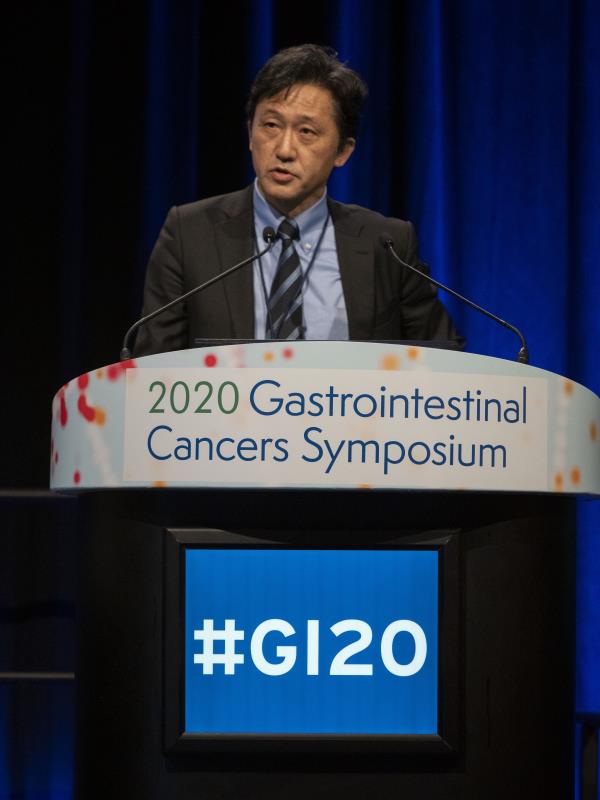 Dr Yukihide Kanemitsu (Photo by ©ASCO/Todd Buchanan 2020)
Dr Yukihide Kanemitsu (Photo by ©ASCO/Todd Buchanan 2020)Primary tumour resection (PTR) prior to a chemotherapy regimen does not improve survival outcomes in patients with asymptomatic unresectable stage IV colorectal cancer (CRC), according to the phase III JCOG1007* trial.
“PTR failed to improve overall survival (OS) in CRC patients with asymptomatic primary tumours and synchronous unresectable metastases,” said study author Dr Yukihide Kanemitsu from the National Cancer Center Hospital, Tokyo, Japan, who presented the results at ASCO GI 2020.
A total of 160 adults (age 20–74 years; median age 65 years) with asymptomatic unresectable stage IV CRC and ECOG performance status of 0 or 1 were randomized 1:1 to undergo chemotherapy alone (bevacizumab plus either mFOLFOX6 or CapeOX**; n=82) or PTR*** followed by chemotherapy 8–56 days later (n=78). A majority of the patients in both groups received the bevacizumab plus mFOLFOX6 regimen (n=65 and 57, respectively). Bone or brain metastases, history of chemo- or radiotherapy, ascites beyond the pelvic cavity, intestinal obstruction, perforation, or fistulation, and active bleeding were among criteria for exclusion.
Tumour location was primarily the colon (93 and 92 percent of chemotherapy-only and PTR + chemotherapy groups, respectively).
At a median follow-up of 22 months, OS did not significantly differ between chemotherapy only and PTR + chemotherapy recipients (median 26.7 vs 25.9 months; 3-year OS, 32.1 percent vs 33.4 percent; hazard ratio [HR], 1.10, 95 percent confidence interval [CI], 0.76–1.59; one-sided p=0.69). [ASCO GI 2020, abstract 7]
Progression-free survival (PFS) was also comparable rate between chemotherapy-only and PTR + chemotherapy recipients (median 12.1 vs 10.4 months; 3-year PFS, 3.2 percent vs 5.6 percent; HR, 1.08, 95 percent CI, 0.77–1.50).
Grade 3–4 neutropenia occurred at a similar rate between chemotherapy-only and PTR + chemotherapy recipients (35 percent in each group), as did leukopenia (10 percent vs 11 percent). However, more PTR + chemotherapy recipients experienced grade 3–4 paraesthesia or diarrhoea (5 percent vs 1 percent for both AEs), hypertension (17 percent vs 8 percent), and neuropathy (14 percent vs 9 percent). Grade 3–4 non-haematological chemotherapy-related AEs also occurred more frequently in PTR + chemotherapy compared with chemotherapy-only recipients (49 percent vs 36 percent).
There were three treatment-related deaths in the PTR + chemotherapy arm that occurred due to postoperative complications. “PTR was [also] associated with more frequent and more severe chemotherapy-related AEs,” said Kanemitsu.
Among patients who responded to chemotherapy, the number of R0 resections in both groups was low, with fewer patients in the PTR + chemotherapy compared with the chemotherapy-only group requiring R0 resection (3 percent vs 5 percent). Thirteen percent of patients in the chemotherapy-only group required palliative surgery for symptoms related to the primary tumour.
There is currently no consensus regarding resection of the primary tumour in patients with asymptomatic synchronous unresectable metastatic CRC, said Kanemitsu.
“[These results show that] chemotherapy remains the standard therapy for asymptomatic unresectable stage IV CRC patients,” he said, noting that PTR is not recommended in this population.